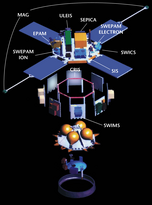Advanced Composition Explorer
| Advanced Composition Explorer | ||||||||||
|---|---|---|---|---|---|---|---|---|---|---|
 ACE space probe |
||||||||||
| NSSDC ID | 1997-045A | |||||||||
| Mission goal | L1 | |||||||||
| Client |
|
|||||||||
| Launcher | Delta II 7920-8 D247 | |||||||||
| construction | ||||||||||
| Takeoff mass | 752 kg | |||||||||
| Course of the mission | ||||||||||
| Start date | August 25, 1997, 14:39 UTC | |||||||||
|
||||||||||
The Advanced Composition Explorer shortly ACE is the name of a spacecraft of NASA , which has been started on 25 August 1997th ACE was implemented as part of the Explorer program and therefore bears the name Explorer 71 .
mission
The aim of the 752 kg probe is to analyze solar, interplanetary, interstellar and cosmic particles at the boundary of the earth's gravitational field near the Lagrange point L 1 . The interplanetary magnetic field with the vectors Bx, By, Bz (Bz value) with the sum vector Bt and also the solar wind with speed and density (English "density", orange scale ) is measured and for a short time recorded over an interval of 7 days (see web link). It was launched on a Delta II 7920-8 and positioned in orbit around L 1 in which it is likely to operate until around 2024. The probe is still active despite an instrument malfunction.
The successor DSCOVR has also been orbiting L 1 since 2015 . Both are to remain in operation in parallel for the time being.
description
ACE is a spacecraft with a main body 1.6 m in diameter and 1 m in height. This is octagonal. A total of four solar cell paddles are attached to it: one on every other side. Two opposite paddles also have rods with magnetometers at their ends. The solar cells are equipped with paddle silicon - solar cell is covered with radiation shielding quartz. At the end of the five-year primary mission (2002) you should still generate 440 watts, which is more than the 425 watts that ACE consumes at its maximum. With extended solar cell paddles and magnetometer, ACE has a diameter of approx. 8.3 m. ACE had a takeoff weight of 785 kg and 189 kg of hydrazine as fuel on board. ACE rotates at five revolutions per minute for spin stabilization . The axis is aligned along the earth-sun line. ACE has two communication systems that work in the S-band .
| ACEs train | |

|

|
| Structure of the ACE | Start: ACEs Delta II 7920-8 |
Web links
- Advanced Composition Explorer (ACE )
- Advanced Composition Explorer (ACE) Mission Overview (English)
- ACE Real-Time Solar Wind , 7-day solar wind record - National Oceanic and Atmospheric Administration (NOAA)website
- The Advanced Composition Explorer (PDF, 24 pages, English; 251 kB)
Individual evidence
- ↑ interplanetary magnetic field , working group meteors , accessed on August 29, 2018th


